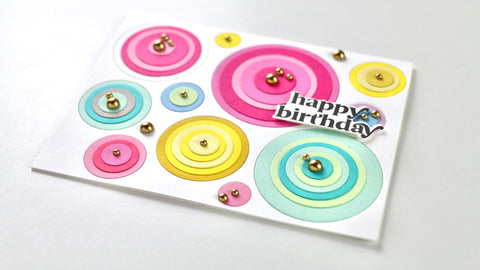Stop Overthinking Your Cards with These 7 Tips!
Last Updated: July 1, 2025
Crafting is a journey of creativity and self-expression. Yet, it’s easy to fall into the trap of overthinking your designs, doubting your choices, and second-guessing every detail. This can stifle your creative flow and turn a joyful hobby into a frustrating task. So how do you recognize when it’s time to step back, trust your instincts, and let your creativity shine?

This blog will guide you through strategies to help you find your flow and embrace the art of letting go in your card making projects.
How to Stop Overthinking When It Comes to Creating Cards
1. Recognizing the Signs of Overthinking
Overthinking can sneak into your crafting process without you realizing it. At first, it might seem like you’re simply being thorough. However, over time, it can drain your energy and hinder your creativity. It’s important to recognize when this happens so you can take a step back.
Some telltale signs of overthinking include spending too much time on minor details, hesitating to make decisions, or repeatedly reworking a project. You might find yourself questioning your choices or comparing your work to others, leading to feelings of frustration. If this sounds familiar, pause and remind yourself that crafting is about joy and self-expression.

Signs of Overthinking:
- You spend too much time on small details. Be mindful when you're caught up in perfecting something that won't significantly impact the overall design.
- Indecisiveness. If you’re stuck between options, choose one and commit to it.
- Comparison. Focus on your unique style instead of comparing your work to others.

2. Trusting Your Initial Instincts
Your first instinct is often your most authentic and creative response. It’s easy to second-guess yourself, especially if you’re striving for perfection. However, trusting your gut can streamline your process and produce stunning results.
Start by embracing the idea that crafting is a journey, not a destination. Each project reflects your creativity at that moment. Trusting your instincts means letting go of fear and allowing yourself to experiment without judgment. Remember, the most beautiful cards often have an effortless charm because they reflect spontaneity.
Tips!
- Set a Time Limit. Allocate a set amount of time for decisions, such as choosing colors or layouts.
- Practice Imperfection. Celebrate the handmade quality of your cards by appreciating their uniqueness.

Create 4 Backgrounds in One Go!
3. Simplify Your Process
Sometimes less truly is more. When you simplify your process, you remove unnecessary obstacles that contribute to overthinking. By paring down your options, you can focus on what matters most: the message and design of your card.

What to Do with Leftover Paper Scraps
For instance, limiting the supplies you use for a project can help reduce decision fatigue. A curated selection of stamps, inks, and embellishments allows you to focus on the creative process rather than being overwhelmed by choices. Clean and simple (CAS) card designs are particularly helpful for creating quick yet impactful projects without overcomplicating things.

Tips!
- Limit Your Supplies: Pick a small set of crafting supplies to streamline your choices and stay focused. In case you still haven’t tried our One-Go series, this is your sign! We’ve created these to streamline the stamping, die-cutting, and hot foiling process so you can spend more time crafting.

One Layer Floral Birthday Card
- Embrace CAS Designs: Create elegant cards with minimal elements that still deliver a big impact.
- Use Pre-Designed Elements: Incorporate pre-stamped images or die-cuts for a head start on your designs. Washi tapes, ephemeras, and stickers are perfect for quick and easy designs and decorations.

4. Set a Clear Vision
Before diving into a project, take a moment to reflect on what you want to achieve. A clear vision provides direction and keeps you grounded when doubts creep in. Start by asking yourself: What is the purpose of this card? Is it for a specific occasion or recipient? What mood or message do you want to convey?
This intentional approach helps you focus on the essence of your card. By clarifying your goals upfront, you’re less likely to get distracted by unnecessary details. For instance, if you’re designing a birthday card for a child, prioritize playful colors and whimsical patterns instead of overcomplicating the layout.

Tips!
- Define Your Goal. Identify the purpose of your card and the message you want to convey.
- Keep the Recipient in Mind. Design with their preferences and personalities in mind.


5. Lean Into Playfulness
One of the best ways to overcome overthinking is to reframe crafting as a playful activity rather than a task. When you allow yourself to experiment without the pressure of perfection, you’ll discover new techniques and ideas that you wouldn’t have considered otherwise.

Participating in crafting challenges is an excellent way to foster playfulness. These challenges often have themes or constraints that encourage you to think outside the box and explore different styles. Additionally, consider creating practice pieces or doodles to warm up your creativity without worrying about the final result.
Tips!
- Try Crafting Challenges: Use prompts and themes to inspire creative solutions and minimize decision-making stress.
- Doodle and Experiment: Create without judgment by trying new techniques or combining unusual elements.

6. Know When to Stop
It’s easy to fall into the trap of endlessly tweaking your design. However, there comes a point when additional changes no longer enhance your project but instead clutter it. Knowing when to stop is an essential skill that will keep your process enjoyable and efficient.
Step back and assess your work from a distance.
Does the card feel balanced and cohesive? Are the elements working together harmoniously?
If the answer is yes, it’s time to call it complete. Trust your intuition and take pride in your creation.
Tips!
- Look for Balance: Ensure your design feels visually balanced without overcrowding it.
- Embrace Completion: Stop once the card fulfills its purpose and looks cohesive.

7. Recharge Your Creativity
If you find yourself stuck in a cycle of overthinking, it may be time to step away and recharge. Taking breaks can help you return to your projects with fresh eyes and renewed energy. Whether it’s spending time outdoors, engaging in a different hobby, taking online crafting classes, or seeking inspiration online, recharging allows your mind to reset.
Connecting with a community of fellow crafters is another excellent way to stay inspired. Sharing ideas and receiving encouragement can reignite your passion and help you see your projects from new perspectives.
- Take Breaks. Step away from your crafting space to refresh your mind. While taking a break, why not listen to some fun, crafting-related podcasts? *wink*
- Engage with the Community. Share your work and gather inspiration from others. If you still haven’t joined our Facebook Fan Group, you're missing out! JOIN HERE.

Stop Overthinking and Start Creating Today!
Overthinking can hinder creativity, but with the right strategies, you can find your flow and let your instincts guide your cardmaking projects. Trust your creativity, simplify your approach, and embrace the joy of crafting. Remember, your handmade cards are unique expressions of your artistry—and that’s what makes them truly special.
Find your flow and refresh your skills with more content like this. Visit us In the Craft Room today!
In This Article
More Crafty Reads & Inspirations
-

Starting 2026 With a Clean Slate and Using Up Leftovers
-

January 2026 Inspiration Challenge
-

Simple Tips To Bring Your Die Cut Florals To Life - A Touch of Sparkle With Carissa Wiley
-

3 Secrets for No-Outline Watercoloring: The Art of the Disappearing Line | Perfect Pairings with Jaycee
-

Card Ideas that Symbolize New Beginnings
















